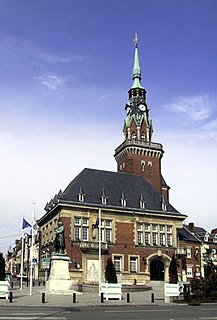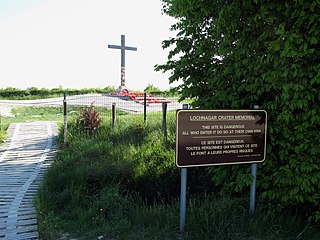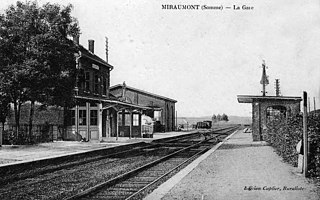
The Battle of the Somme, also known as the Somme Offensive, was a battle of the World War I fought by the armies of the British Empire and French Third Republic against the German Empire. It took place between 1 July and 18 November 1916 on both sides of the upper reaches of the River Somme in France. The battle was intended to hasten a victory for the Allies and was the largest battle of the First World War on the Western Front. More than three million men fought in the battle and one million men were wounded or killed, making it one of the bloodiest battles in human history. The Battle of the Somme was fought in the traditional style of World War I battles on the Western Front: trench warfare. The trench warfare gave the Germans an advantage because they dug their trenches deeper than the allied forces which gave them a better line of sight for warfare. The Battle of the Somme also has the distinction of being the first battle fought with tanks. However, the tanks were still in the early stages of development, and as a result, many broke down after maxing out at their top speed of 4 miles per hour.

BapaumeFrench pronunciation: [](listen) is a commune in the Pas-de-Calais department in the Hauts-de-France region of northern France.

Ovillers-la-Boisselle is a commune in the Somme department in Hauts-de-France in northern France.

The Hundred Days Offensive was an Allied offensive which ended the First World War. Beginning with the Battle of Amiens on the Western Front, the Allies pushed Central Powers back after their gains from the Spring Offensive. The Germans eventually retreated to the Hindenburg Line, culminating in the Armistice of 11 November 1918. The term "Hundred Days Offensive" does not refer to a battle or strategy, but rather the rapid series of Allied victories against which the German armies had no reply.

The Second Battle of the Somme of 1918 was fought during the First World War on the Western Front from late August to early September, in the basin of the River Somme. It was part of a series of successful counter-offensives in response to the German Spring Offensive, after a pause for redeployment and supply.

The Battle of Bapaume was a battle during the Franco-Prussian War which defeated French attempts to relieve the besieged city of Péronne, Somme. The battle was fought on 3 January 1871 near the town of Bapaume.

Vaulx-Vraucourt is a commune in the Pas-de-Calais department in the Hauts-de-France region of France.

Biefvillers-lès-Bapaume is a commune in the Pas-de-Calais department in the Hauts-de-France region in northern France.

Combles is a commune in the Somme department in Hauts-de-France in northern France.

Irles is a commune in the Somme department in Hauts-de-France in northern France.

Sailly-Saillisel is a commune in the Somme department in Hauts-de-France in northern France.

Miraumont is a commune in the Somme department in Hauts-de-France in northern France.
The 5th Mounted Rifles was formed on 17 March 1911. It formed part of the Otago Mounted Rifles Regiment so they saw service during the Battle of Gallipoli, Egypt. They later served in France with the New Zealand Division and were the only New Zealand Mounted troops to serve in France.
The 7th (Southland) Mounted Rifles was raised on 17 March 1911. During World War I they formed part of the Otago Mounted Rifles Regiment and served in the Battle of Gallipoli and was then withdrawn to Egypt. They would later serve in France, with the New Zealand Division.
The 12th (Otago) Mounted Rifles was formed 17 March 1911. During World War I they formed part of the Otago Mounted Rifles Regiment and saw service during the Battle of Gallipoli, afterwards they were withdrawn to Egypt and later were the only New Zealand Mounted troops to serve in France with the New Zealand Division.

The Otago Mounted Rifle Regiment was a New Zealand Mounted Regiment formed for service during the Great War. It was formed from units of the Territorial Force consisting of the 5th Mounted Rifles, the 7th (Southland) Mounted Rifles and the 12th (Otago) Mounted Rifles. They saw service during the Battle of Gallipoli, with the New Zealand Mounted Rifles Brigade and was later withdrawn to Egypt. They later left the brigade and served in France with the New Zealand Division becoming the only New Zealand Mounted troops to serve in France.
Battle of Albert was the third battle by that name fought during World War I, following the First Battle of Albert and the Second Battle of Albert, with each of the series of three being fought roughly two years apart. This smaller third battle was significant in that it was the opening push that would lead to the Second Battle of the Somme and involved the Australian Corps. This attack opened the advance, with the main attack being launched by the Third Army along with support from the Fourth Army. The Second Battle of Bapaume, from 25 August to 3 September, was a continuation of this battle.
Battle of Bapaume may refer to:
Bancourt British Cemetery is a Commonwealth War Graves Commission burial ground for the dead of the First World War located in the Pas de Calais region of France, on the Western Front.
















